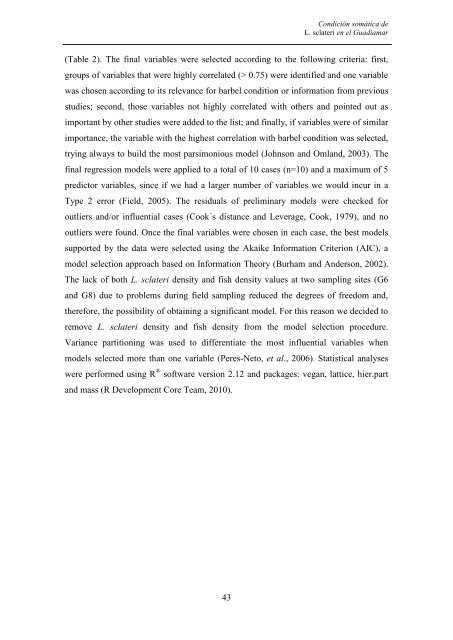las comunidades de peces del río guadiamar y el accidente minero ...
las comunidades de peces del río guadiamar y el accidente minero ...
las comunidades de peces del río guadiamar y el accidente minero ...
You also want an ePaper? Increase the reach of your titles
YUMPU automatically turns print PDFs into web optimized ePapers that Google loves.
Condición somática <strong>de</strong><br />
L. sclateri en <strong>el</strong> Guadiamar<br />
(Table 2). The final variables were s<strong>el</strong>ected according to the following criteria: first,<br />
groups of variables that were highly corr<strong>el</strong>ated (> 0.75) were i<strong>de</strong>ntified and one variable<br />
was chosen according to its r<strong>el</strong>evance for barb<strong>el</strong> condition or information from previous<br />
studies; second, those variables not highly corr<strong>el</strong>ated with others and pointed out as<br />
important by other studies were ad<strong>de</strong>d to the list; and finally, if variables were of similar<br />
importance, the variable with the highest corr<strong>el</strong>ation with barb<strong>el</strong> condition was s<strong>el</strong>ected,<br />
trying always to build the most parsimonious mo<strong>de</strong>l (Johnson and Omland, 2003). The<br />
final regression mo<strong>de</strong>ls were applied to a total of 10 cases (n=10) and a maximum of 5<br />
predictor variables, since if we had a larger number of variables we would incur in a<br />
Type 2 error (Fi<strong>el</strong>d, 2005). The residuals of pr<strong>el</strong>iminary mo<strong>de</strong>ls were checked for<br />
outliers and/or influential cases (Cook´s distance and Leverage, Cook, 1979), and no<br />
outliers were found. Once the final variables were chosen in each case, the best mo<strong>de</strong>ls<br />
supported by the data were s<strong>el</strong>ected using the Akaike Information Criterion (AIC), a<br />
mo<strong>de</strong>l s<strong>el</strong>ection approach based on Information Theory (Burham and An<strong>de</strong>rson, 2002).<br />
The lack of both L. sclateri <strong>de</strong>nsity and fish <strong>de</strong>nsity values at two sampling sites (G6<br />
and G8) due to problems during fi<strong>el</strong>d sampling reduced the <strong>de</strong>grees of freedom and,<br />
therefore, the possibility of obtaining a significant mo<strong>de</strong>l. For this reason we <strong>de</strong>ci<strong>de</strong>d to<br />
remove L. sclateri <strong>de</strong>nsity and fish <strong>de</strong>nsity from the mo<strong>de</strong>l s<strong>el</strong>ection procedure.<br />
Variance partitioning was used to differentiate the most influential variables when<br />
mo<strong>de</strong>ls s<strong>el</strong>ected more than one variable (Peres-Neto, et al., 2006). Statistical analyses<br />
were performed using R ® software version 2.12 and packages: vegan, lattice, hier.part<br />
and mass (R Dev<strong>el</strong>opment Core Team, 2010).<br />
43

















